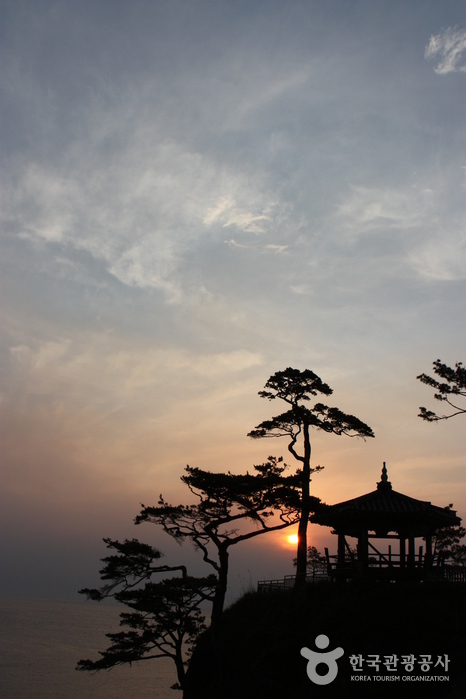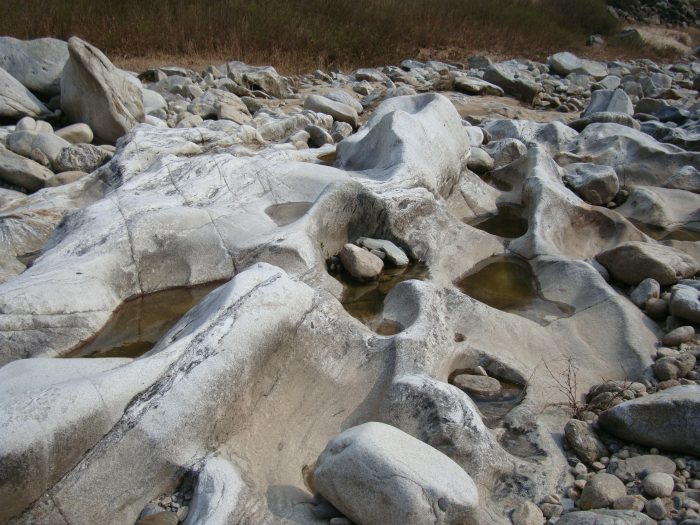Goseokjeong National Tourist Area (고석정국민관광지)
2023-03-07
1825, Taebong-ro, Cheorwon-gun, Gangwon-do
+82-33-450-5558
Goseokjeong Pavilion is the most scenic spot among the eight scenic views of Cheorwon. The crystal clear waters of the Hantangang River wind around Goseokbawi Rock, a peculiarly shaped rock about 10 meters tall that stands dominantly in the middle of the river. Goseokjeong Pavilion is a two-story tower-style pavilion that has an area of about 33 square meters, built halfway up the Hantangang River during the reign of King Jinpyeong (r. AD 579-632) of the Silla Kingdom. Today, Goseokjeong refers to the entire area around Goseokjeong Pavilion and the valley surrounding Goseok Rock. Designated as a Monument of Gangwon-do, the pavilion is known to have been one of the most favored places by King Jinpyeong of the Silla Kingdom, and King Chungsuk of the Goryeo dynasty. The area became all the more famous as the arena of Im Kkeok-jeong (?-1562), who was a legendary leader of a peasant rebellion in the early Joseon dynasty.
The pavilion was destroyed during the Korean War and restored in 1971 by community leaders in Cheorwon. Unfortunately, it was damaged once again by flood in 1996 and reconstructed the year after. There is a natural stone chamber inside Goseokbawi Rock that Im Kkeok-jeong used as a hiding place. On the opposite side, there are remains of a stone castle. Jiktang Waterfall is located about 2 kilometers up from this site, while Sundam Valley is situated about 2 kilometers in downstream. Goseokjeong is a year-round tourist attraction with an extensive grass square and recreational facilities. It is also the starting point for DMZ tours as the Iron Triangle Battlefield Conservation Office is located here and in winter, visitors can enjoy migratory bird tours.
Gwangalli Beach (광안리해수욕장)
2025-04-14
219 Gwanganhaebyeon-ro, Suyeong-gu, Busan
+82-51-622-4251
Located to the west of Haeundae Beach, Gwangalli Beach is 1.4 kilometers long and 25~110 meters wide, and is famous for its fine sand. The area underwent a water purification process, which led the ecosystem to flourish in the nearby river waters. In addition to the beachfront, the Gwangalli area is filled with delicious restaurants and romantic cafes, as well as stores selling famous fashion brands. The area has plenty to offer, but many people come in the evening to take in the bright lights of Gwangandaegyo Bridge, stretching across the horizon.
Seoraksan Gwongeumseong Fortress (설악산 권금성)
2024-02-28
1091 Seoraksan-ro, Sokcho-si, Gangwon-do
+82-33-636-7700
Gwongeumseong Fortress is a stone castle from the Goryeo dynasty and is located 800 meters above sea level in Seoraksan National Park. From a distance, Gwongeumseong Fortress looks like a rising peak, while up close, the expansive stone floor and remnants of castle walls become visible. Visitors can access the fortress via hiking trails or by taking a cable car. From the fortress, visitors can enjoy the majestic view of Seoraksan Mountain and the blue waters of the East Sea.
Eulsukdo Migratory Bird Park (을숙도 철새공원)
2021-04-23
1240, Nakdongnam-ro, Saha-gu, Busan
+82-51-209-2031
Eulsukdo Migratory Bird Park, designated as Natural Monument No. 179, is located in the lower part of Elsukdo Island. Renovated in 2009, the park is the central area for migratory bird habitats and ecology tourism. In winter, migratory birds can be seen at the wetlands. Nakdong Estuary Eco Center in the park provides information on various eco-life of the area as well as treat injured wild animals.
Naksan Provincial Park (낙산도립공원)
2018-01-25
59, Haemaji-gil, Yangyang-gun, Gangwon-do
+82-33-670-2518
Naksan Provincial Park takes up 24km of shoreline in Yangyang, Gangwon-do. The park is centered on Naksansa Temple and Naksan Beach, but includes Osan, Dongho, and Hajodae Beaches, as well as many lakes and cliffs. The park is a great place to learn about Korean culture, including Buddhist culture at Naksansa Temple and other cultural relics, and the shoreline cliffs of pine trees. The park is a popular attraction in the summer, when visitors can swim in the ocean and play in the sand along the coast.
Naerincheon River Pothole-Gangwon Peace National Geopark (내린천 포트홀-강원평화지역 국가지질공원)
2019-09-04
Buk-ri, Girin-myeon, Inje-gun, Gangwon-do
+82-33-249-3881
Naerincheon River starts out as a small stream on Bungnyongsan Mountain and flows down Sogyebangsan Mountain before joining with other small valley streams to create the larger river that most people know. The river has created a valley with many interesting and uniquely shaped rocks as it flowed down the mountainside over the years. The waters are so pure, the small pebbles and sand lining the bottom of the stream can be seen clearly. There are a number of areas along the stream perfect for relaxing and enjoying some time in nature. Many families visit and enjoy fishing and the pure environment. The river is also well-known for rafting.
Gyeongpoho Lake (경포호(철새도래지))
2025-08-08
365 Gyeongpo-ro, Gangneung-si, Gangwon-do
Gyeongpoho Lake is a popular attraction, with beautiful natural scenery and many cultural relics nearby. The view of the moon reflecting off the lake from Gyeongpodae Pavilion is especially stunning. The 1,256,204 m² naturally formed lake is connected to the ocean, and is famous as a destination site for migratory birds in winter. There are also many fish in the lake, but the lake has been designated as a nature protection site and fishing is prohibited.
Guryongsa Temple (구룡사)
2022-12-21
500, Guryongsa-ro, Wonju-si, Gangwon-do
+82-33-732-4800
Guryongsa Temple is located 6 kilometers from Birobong Peak on Chiaksan Mountain, in the direction of Hakkok-ri. It was believed that Monk Uisang (625-702) of the Silla Kingdom (57 BC - AD 935) built and named the temple Guryongsa in 668 during the reign of King Munmu. However, it is now known that the temple was built after King Sukjong, the 19th King of the Joseon dynasty (1392-1910), who reigned from 1674 to 1720, because of the architectural style of Daeungjeon Hall. There is a legend that the Guryongsa Temple site was originally a lake where nine dragons lived. The name Guryong comes from the story that the lake was filled up to build the temple on it. There are many buildings such as Daeungjeon Hall, Bogwangnu Pavilion, Samseonggak Pavilion, Simgeomdang Hall and Seolseondang Hall. Daeungjeon Hall has maintained its original shape though it was repaired many times.
Naksansa Temple (낙산사)
2025-10-23
100 Naksansa-ro, Yangyang-gun, Gangwon-do
+82-33-672-2475
This ancient temple was built in the 11th year of King Munmu’s reign of Silla (671) by the Buddhist monk Uisang. Naksansa Temple is one of the foremost sights of Yangyang, and one of the most historic sites in the region. Along with Ganghwa’s Bomunsa Temple and Namhae’s Boriam Hermitage, it is said to be one of the three centers of the cult of Avalokitesvara in Korea. Its handsome view overlooking the East Sea has earned it a spot in the Eight Sights of Gwandong (eight famous sights in Yeongdong region of Gangwon-do), documented throughout the ages in many classic literature and poetry. Today’s Naksansa Temple is a product of many restorations and expansions, and has many examples of cultural heritage within its walls, including a 16 meter-tall statue of the Avalokitesvara Bodhisattva. A mountain fire in 2005 resulted in the loss of 20 buildings, including the building that housed its bronze bell. The temple also operates templestay programs available through its website.
Nami Island (남이섬)
2025-10-23
1, Namiseom-gil, Chuncheon-si, Gangwon-do
+82-31-580-8114
Nami Island, with the concept of “Fairy Tale Village and Song Village,” provides various cultural events, concerts, exhibitions, and more to give children dreams and hopes, couples' love and memories, and artists a space for creativity. Tourists can enjoy facilities including Song Museum, Picture Book Playground, MICE Center, and various activities such as Charity Train, Story Tour Bus, Bicycle, etc. Restaurants provide delicious food with carefully selected local ingredients and Hotel Jeonggwanru has themed accommodations.






 English
English
 한국어
한국어 日本語
日本語 中文(简体)
中文(简体) Deutsch
Deutsch Français
Français Español
Español Русский
Русский